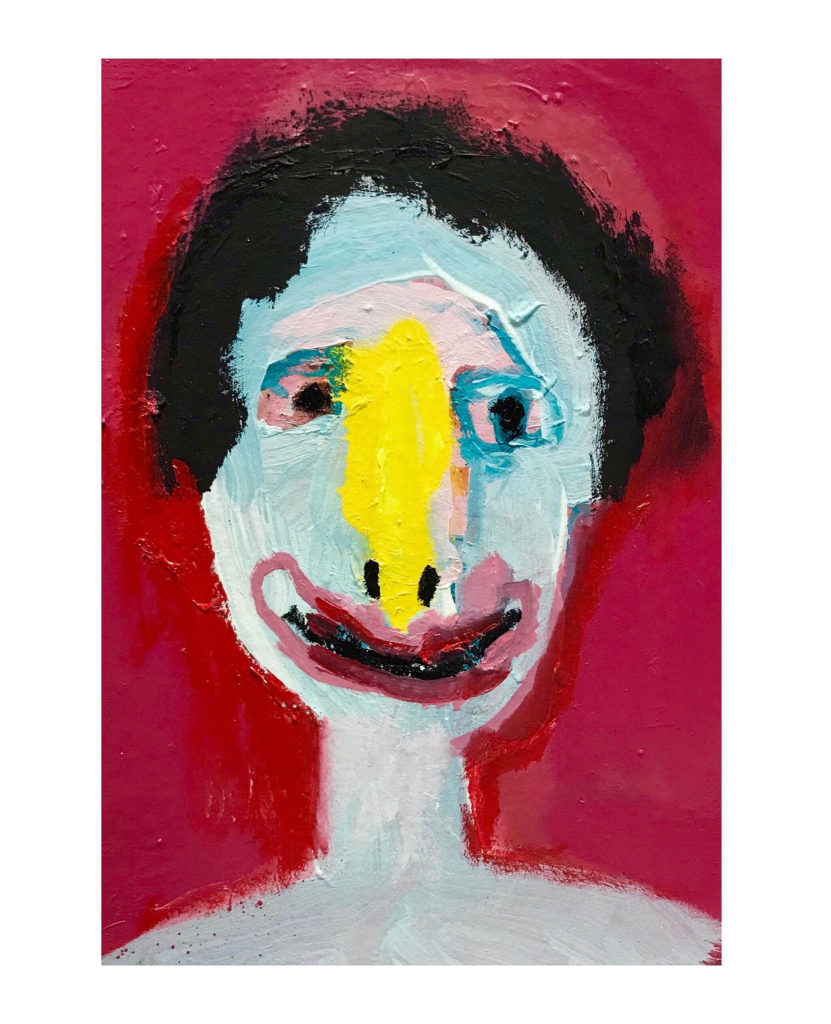Bio:
Luciano Suárez, born Buenos Aires, 1976, graduated in Fine Arts in 2004 ( UCM) after earning a prestigious Erasmus Scholarship at Leeds Metropolitan University in 2003.
Following his formal education, Suarez spent two years in Norway developing his craft before returning to Madrid where he settled in the Noviciado 9 Studio and continued to hone his pictorial work, with a focus on the contextual influence of the city.
His scholarly pursuits centred on the hypothetical assumption that fundamental to humanity are the elements of ludens (play) and faber (creation or work), elements that are exemplified when combined and expressed through the purity of painting. This concept derived from Luciano’s study of the first avant-gardes, such as surrealism or Dadá art movements, as well as art Brut, Bad Painting or Neue Wilden genres.
In recent years, Luciano Suárez’s work has transgressed from the figurative, towards an abstract interpretation of figures, that compels scrutiny with compositional structures that are sometimes clear and sometimes hidden behind several layers of paint. His work lends to the philosophical sphere with intellectual engagement necessary to appreciate the subjective aesthetic of his work. Foundational to his ethos is that it is both the understated significance and the spectacle of art that is crucial to artistic integrity.
In Spain, Suárez has exhibited at Real Theater (Madrid, 2023), Hub 27 (Madrid 2019), the exhibition hall of the Huesca provincial council (2016), La Casa Encendida (2014), Matadero (2014), Centro Conde Duque (2013), El Silo de Hortaleza (Madrid, 2009), Rojo Maquina Gallery (Madrid, 2007) and Internationally at Hudgraf Gallery (Kiev, Ukraine 2008) and 19KAREN Contemporary Artspace (Gold Coast, Australia).
Statement:
Luciano Suárez (Buenos Aires, 1976) se licencia en Bellas Artes por la UCM en 2004 y cursa su último año universitario en la Leeds Metropolitan University. Después de un año en la ciudad inglesa se traslada a Noruega y allí pasa dos años trabajando en diferentes proyectos artísticos. A su vuelta a Madrid se instala en el estudio Noviciado 9 donde continúa su trabajo pictórico. En 2007 funda el colectivo de artistas Montaña Sagrada y empieza a desarrollar su obra centrada en el contexto madrileño.
Inspirada en las hipótesis o creencias de que el homo es ludens y es faber, desde un punto de vista formal, las referencias a la idea de la pureza de la pintura provienen desde lugares como las primeras vanguardias o las vanguardias históricas como el surrealismo o Dadá, así como del art Brut, Bad Painting o Neue Wilden.
Durante estos últimos años el trabajo de Luciano Suárez se ha desarrollado a partir de una base pictórica cercana a la figuración. En ocasiones más visible y clara y en otras mucho más oculta tras capas y capas de pintura que han ido contruyendo una estructura compositiva alejada del todo de la figuración originaria. De este modo y aproximándose a tendencias de reacción frente al arte intelectual o frente al academicismo las temáticas de su pintura responden siempre a un hecho diferenciador y básicamente personal.
El reverso de la escena, la parte menos visible y el carnaval en todas sus acepciones son temas fundamentales de su pintura. Y si los motivos figurativos han sido recurrentes también lo es el desarrollo matérico de su trabajo generando texturas, profundidades, goteos o veladuras.
A nivel nacional ha expuesto en el Teatro Real (Madrid 2023), Hub 27 (Madrid 2019), la sala de exposiciones de la Diputación Provincial de Huesca (2016), La Casa Encendida (2014), Matadero (2014), Centro Conde Duque (2013), El Silo de Hortaleza (Madrid, 2009), Galería Rojo Maquina (Madrid, 2007) y a nivel interna- cional en 19KAREN Contemporary Artspace (Gold Coast, Australia 2018) y Hudgraf Gallery (Kiev, Ucrania 2008).
Statement:
Mis últimas obras parten de una serie titulada Aunque no me veas, aquí estoy, que empecé a finales del 2018 y en la que continúo trabajando y experimentando.
Mis piezas son una investigación sobre los procesos y sus huellas, sobre lo no visible en primera instancia, convirtiendo la superficie en memoria.
Con esta idea comencé a trabajar tapando partes mediante capas, superponiendo y ocultando unas con otras hasta hacerlas desaparecer, creando un juego con los diferentes espesores, estratos y el concepto mismo de invisibilidad; este gesto permite convivir los elementos representados bajo un mismo soporte, mostrando las dos caras de la moneda bajo un plano intermedio y obedeciendo a planteamientos analíticos y reflexivos, que tratan de reducir el concepto de la pintura casi al esquema, a lo mínimo, a la esencia y a la idea de lo que es. La figuración deviene abstracción proponiendo un viaje a la inversa, desde dentro hacia afuera de la pintura, abriendo interrogantes y distintas posibilidades al espectadoracerca de lo que está representado en ellas.
